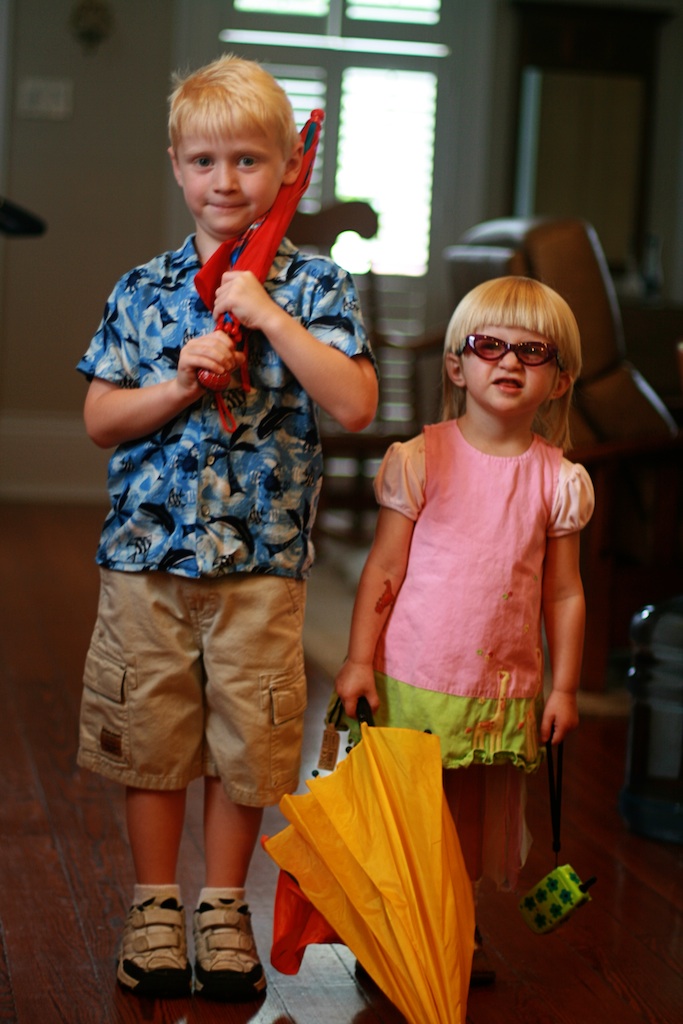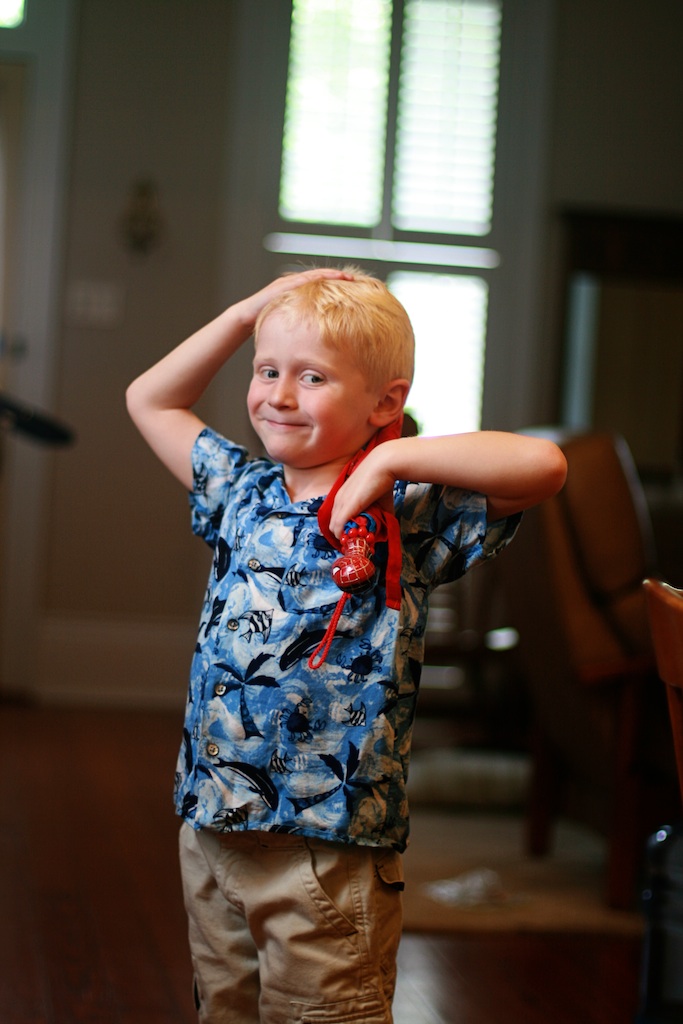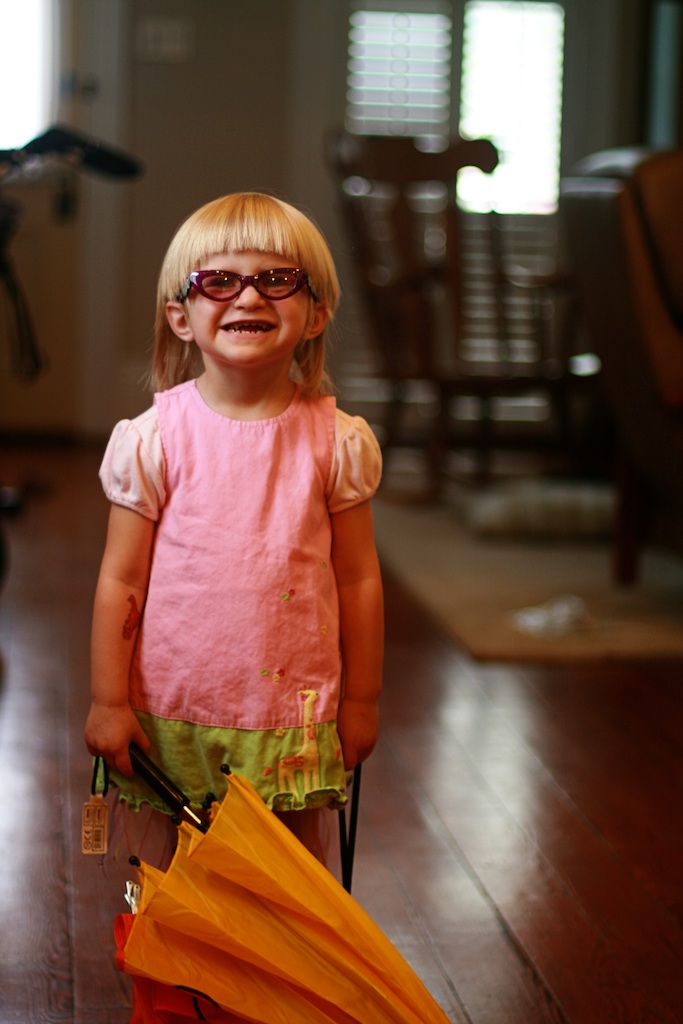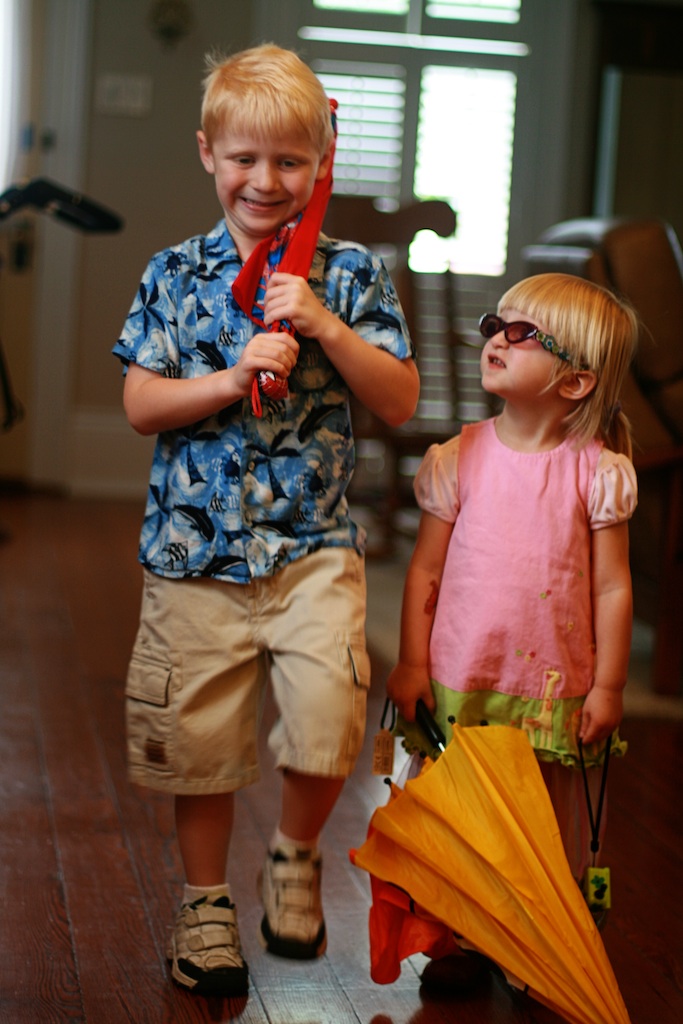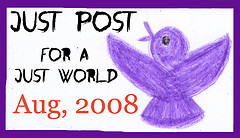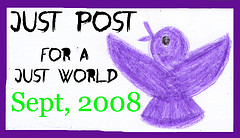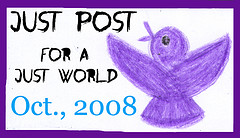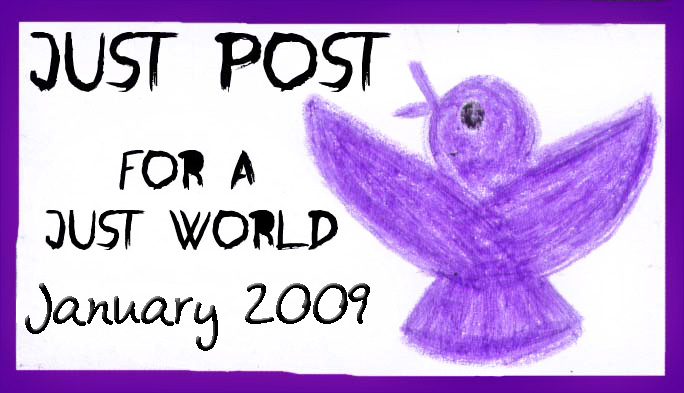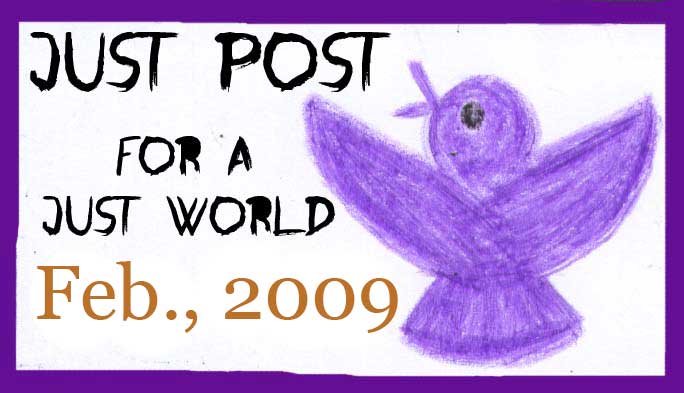{ Monthly Archives }
April 2009
Photohunt: Purple
Purple has been a big color in the Internets this week. First, twitter pages started going purple in honor of little Madeline Spohr. Then in dual purpose of supporting another tragedy with the loss of baby Thalon.
Like so many others, I have spent time and tears this week lurking in the unexplainable, unimaginable loss of a child. I remember the losses of children within my own family and friends and it makes me appreciate the internet a little more… that we can share and educate and act.
These pictures of Kate, wearing purple, seemed an appropriate fit to this week’s theme.






I’m hugging my kids extra tightly. I feel very, very lucky.
Movie Night
Sometime in the not so distant future, Kate is going to come fussing to me to report that her brother held her down and farted on her nose AGAIN with Will on her heals complaining OH NO she was fighting to get that last red flat 8 bump lego piece out of his pocket and it was HER fault and then Kate shouts but you LAUGHED and FARTED and he says OH YEAH, WELL MY FARTS SMELL BETTER THAN YOUR FEET and she…
… and I’ll look at them both dumbfounded and say, “who ARE you people? Do you see this picture? See these sweet angelic children cuddling in bed? These, THESE are my children.”
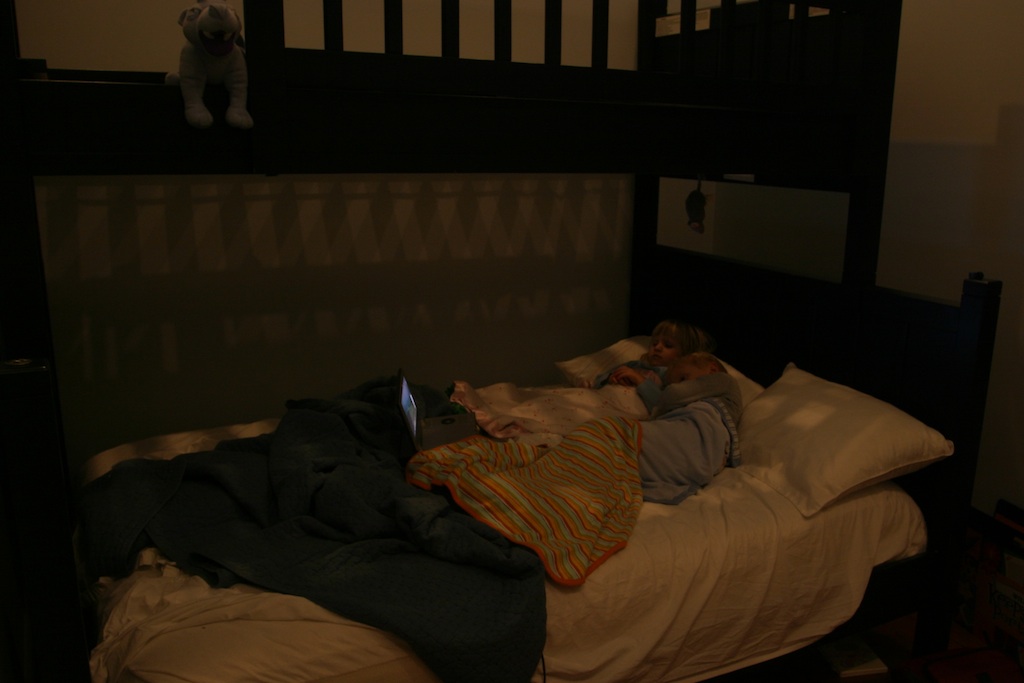
Where I ponder Charity.
Right after All Things Considered, just moments before the classical hour begins, our local public radio station has the owner of a consulting firm give advice in minute’s time. They call it “The Louisiana Rebuilds Minute.” We call it “The WWOZ Minute.” (A friend coined the term, meaning that this is when he switches the radio to the local music station for that minute).
The idea of the Minute is that the people of Southeast Louisiana are too stupid to realize that it just takes a web search to find the answers to all problems related to an unprecedented rebuilding of an American city. Since we’re too idiotic to figure it out, The Minute does it for us. Paul and I have been joking for years that we would make a “Louisiana Rebuilds Minute” Generator — you just add in a common post-Katrina problem, throw in some patronizing ‘pull yerself up from yer bootstraps’ talk, and suggest that one consulting firm’s website has alllll the answers. Insert those few tidbits, press enter, and BOOM, you’ve got your manufactured minute.
The point that The Minute doesn’t get is that JUST BECAUSE there is one organization out there with funds to build playgrounds, doesn’t mean that every school that needs one and applies will get it. JUST BECAUSE one bus is available to a few folks who have the magic combination of ills and scripts to qualify for reduced medicines doesn’t mean that everyone who needs meds can get them. And JUST BECAUSE The Road Home offered funds to some families doesn’t mean they have all that they need to rebuild their homes and lives. Just because there are programs and grants and applications and dollars out there doesn’t mean that they are thought through, that they are honest, that they actual reach the people that they are meant to reach, and that they make any impact at all in the outcomes of our daily lives.
It is easy to get mislead.
It is easy to think that ideas are either good or bad.
I’m not so sure. If I have learned anything from being a part of New Orleans’ recovery, it is that EVERYTHING is mired in thick, silty gray.
And in the middle of all that mess sits Charity Hospital.
One of the big discussions flying around Southeast Louisiana surrounds Charity Hospital. Until Katrina, Charity was the second largest hospital in the country and one of the oldest continuously operating hospitals in the world. It was the primary source for health care for many of New Orleans’ poor. Actually, considering that many of Charity’s former patients have not seen a physician since Katrina, technically, Charity is still their source for health care… it’s just not open for them to receive it.
In fall 2007, Jim Aiken, the LSU University Hospital Chief of Emergency Medicine who worked the Emergency Department through Katrina and the aftermath, came to a class I was assistant teaching. His fascinating lecture included discussion of Charity’s pre-storm emergency plans, his experience of the storm and flood from within Charity, how he helped coordinate emergency care in the extended aftermath, and finally some of the issues involved with long-term planning for health care for the city. At every step, the issues are overwhelming at best — but what struck me was his passionate and pointed arguments for medicine, good medical care, and services to the community. He left me convinced that we need to rebuild a top-tier medical facility in this city, one that serves the poor within it, both because it draws good doctors to gain experience within it and because providing care to those who wouldn’t otherwise receive it is as important in this community as drinkable water and drivable streets.
A little over a week ago, the Schweitzer Fellows held our second symposium. This one was on “The State of Health in Louisiana” and Dr. Larry Hollier, chancellor of LSU health sciences center (encompassing the training programs for all allied health fields at LSU), was one of the speakers. His presentation was about the new LSU health sciences center — a center which is desperately needed, but is incredibly controversial in how it plays out.
The issue is that Louisiana’s doctors come from LSU graduates… by no small amount. The physicians practicing in the State are close to retirement age by overwhelming numbers, and the physicians coming out of LSU are not the type to stick around and take their places. Even before Katrina, LSU was seeing a substantial increase in the numbers of foreign-trained medical students who were ‘matched’ to attend LSU for their residencies — these are students who tend to go back to their home countries after residency. There were also increases in ‘matches’ with students for whom LSU was not a top choice… indeed, has not been a first choice for many in recent years. In addition to bringing in students who are not necessarily going to stick around… LSU has not been attracting the best talent, who are going to get picked up by the more desirable residency programs. Post-Katrina, these enrollment numbers have been even more dire, suggesting that the outlook for Louisiana to have competent, young physicians to support the State’s medical needs into the future is grim. Dr. Hollier argued that plans for a new science center were in place long before Katrina, and that the need for an expanded, updated center for treatment, training, and research was critical to the survival of health care in Louisiana.
And I believe him.
Don’t get me wrong: my impression of the guy was that we’d have some seriously different views on just about any medical or social issue… but the numbers and his argument was compelling. More than that, it completed echoed my experience as a student: my peers don’t stay. Heck, *I* am having trouble figuring out how we’re going to stay. Even if Paul had gainful employment, the fact is that the research dollars to study health inequalities in our city don’t go to researchers in New Orleans. If I want to stay involved in research here, it seems like I need to move to Chapel Hill or Ann Arbor or Boston or wherever in order to do it. (I’ll save this rant for a later date.)
I think that we need a commitment to a new, state-of-the-art facility to attract new talent, house research programs, and rebuild health infrastructure in the city.
Dr. Hollier spoke ONLY of the LSU plans — NOT the combined VA plans. In the LSU plan, only 33 homesites are impacted over an area that encompasses more empty parking lots than businesses or homes. (The VA plan, as outlined in a wonderful advocacy website, impacts many more people and historical properities.) He argued rationally that the Charity hospital building could not be retrofitted to the needs of the new center and any expansion did not include parking or other supportive infrastructure necessary for that sort of facility. He suggested the renovation of Charity as apartments for residents.
Everything that I know about New Orleans and the way things work make me question people in power — question their motives, question their reasoning, wonder about what they haven’t considered. (In contrast, it also has shown me that New Orleanians are some of the most change-resistant people on the planet… but possibly for good reason.) Yet, I am compelled to WANT this new center. I WANT a place where I can collaborate and build and learn and serve. I’m EXCITED about the possibility of this center… it makes me want to be here, stay here, work here.
Those first couple of blocks closest to I-10? The ones that are predominantly occupied by empty parking lots? I can’t think of a better use than to build a new science center.
But. The rest? Well. I’m uncertain about this. Because I feel that Dr. Hollier would drive through a community like lower Mid-City and not see a community worth saving. He wouldn’t necessarily see a pattern of New Orleans rolling over yet another predominantly African-American community for the sake of progress. Or, maybe he would — maybe he would but he would argue it was necessary for the common good. And sometimes? Sometimes I believe in the common good, even if it stomps all over individual rights. Early public health efforts involved holding people down for immunizations against their will… and that is WHY we were able to control disease. Sometimes common good is a good answer.
BUT! Common good should come out of insight and input from the community. That’s what it’s all about. I’m not convinced that LSU are taking alternative plans seriously. I don’t understand why the RMJM Hillier plan isn’t feasible and while I am not convinced it is the right place to go, I do think it signals to LSU that it needs to look for compromise.
And I’m worried that this will be locked in years of debate and at the end, the people of New Orleans will continue to suffer for lack of a comprehensive medical center and a generation of medical talent will slip through our fingers.
There is no easy answer here. And I’m sort of all knotted up inside over it because it involves my field (public health) and my passion (community-level advocating/organizing) — with one tromping on the other in the name of common good.
Got anything good for this one, Louisiana Rebuilds Minute? What website of yours solves this??
(If anyone still reading has thoughts, comments, insight, or ideas… I’d love to hear them.)
What would Top Chef do?
Top Chef was at the Farmer’s Market today. It’s spring break for the kids, so they were there, too… which is why Paul and I weren’t able to stick around for the show and tasting.
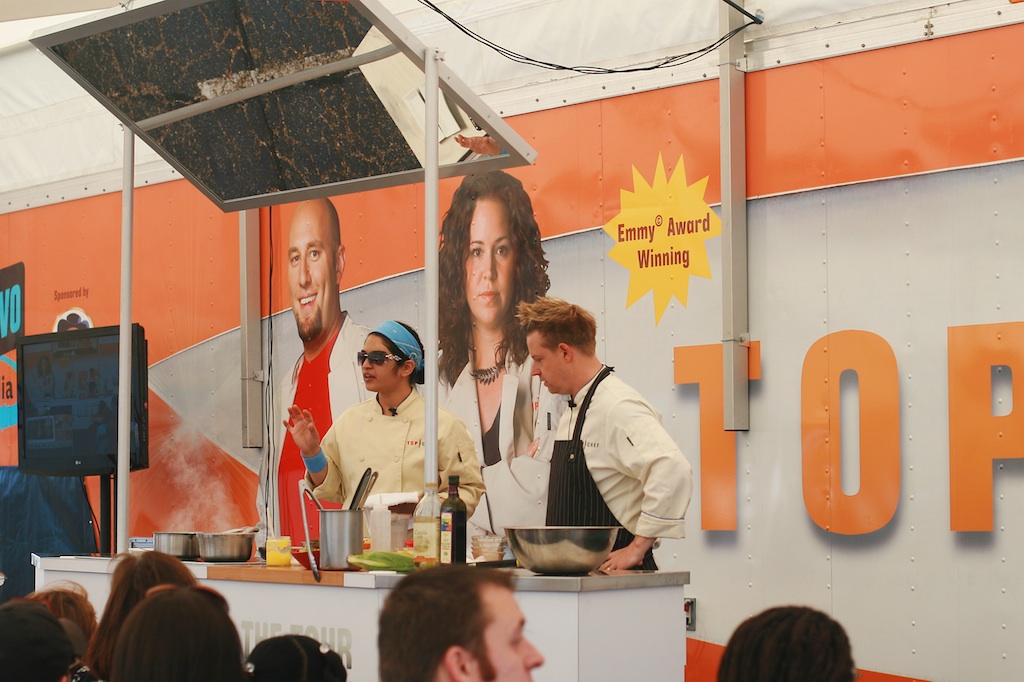
I met Paul and the kids there (I came late from French class), where Paul filled me in that there was to be strictly no video recording and that Radhika had been in a scooter accident yesterday and given herself terrible black eyes. She told the crowd “always wear a helmet,” which, as a ‘learn from me example’ means she must have been really lucky.
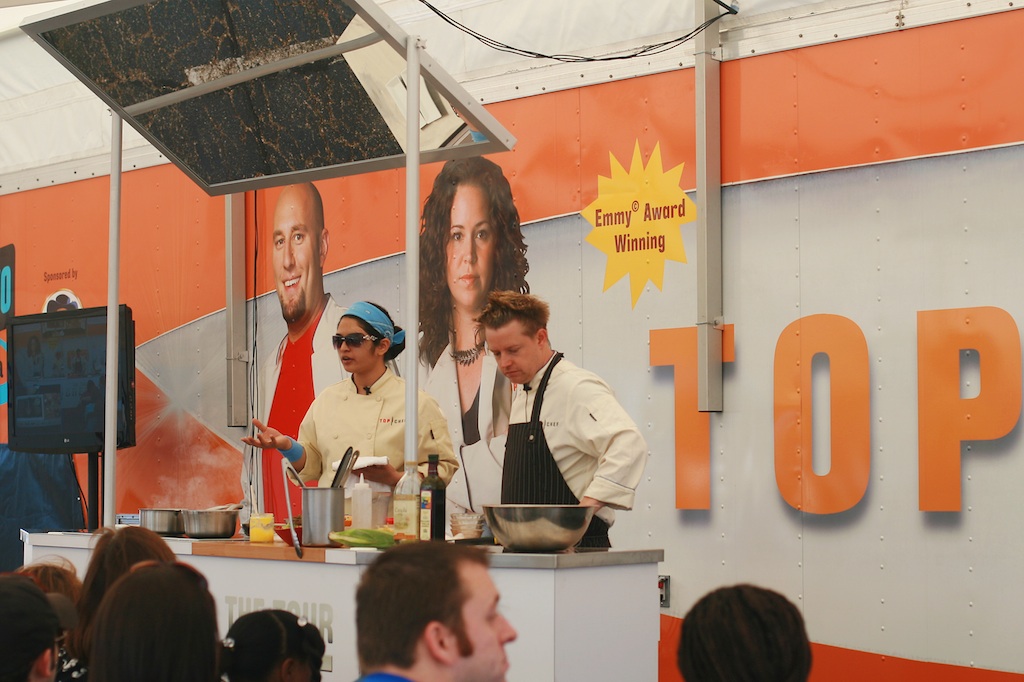
In addition to the chefs, there were games.
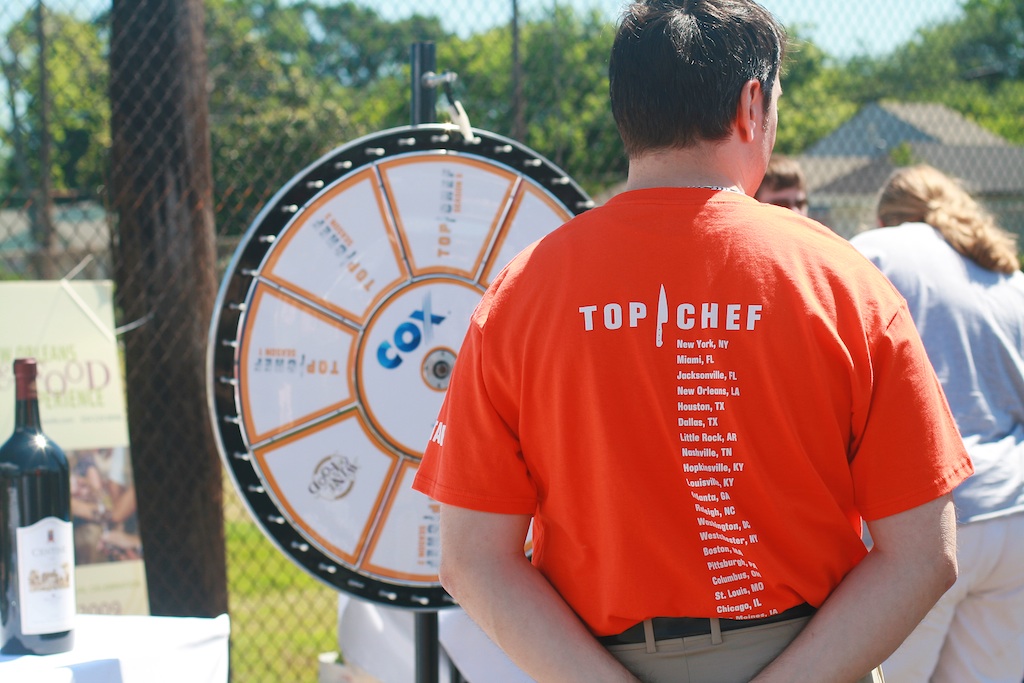
But, at least while we were there, it was all about the food. I loved the big mirror reflecting the cooking area.
Richard was talking about halibut. That’s all I remember.
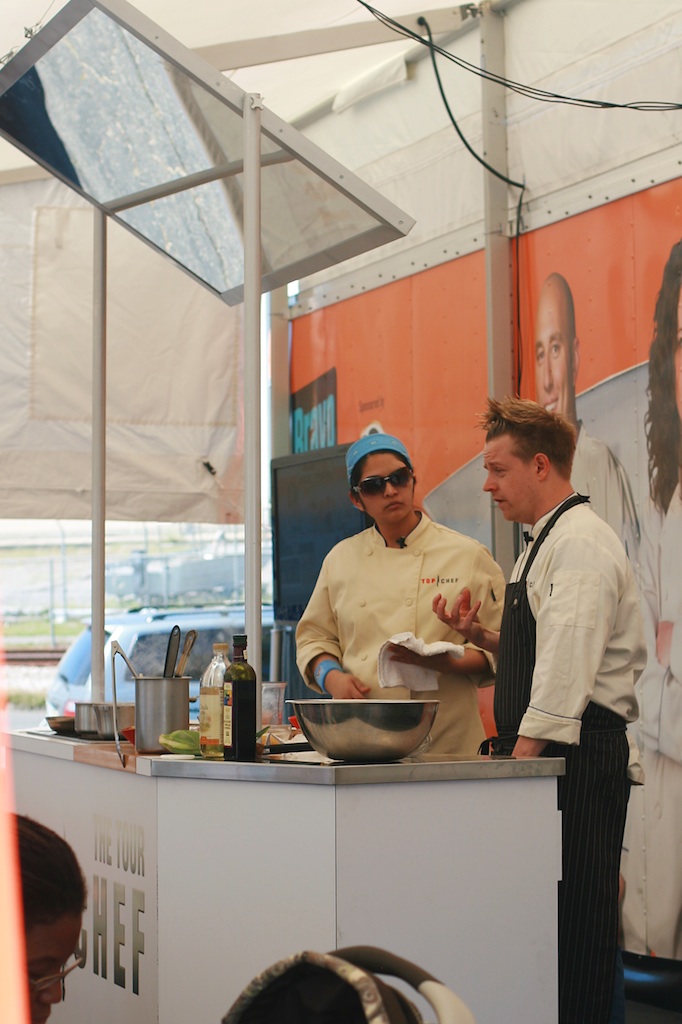
These blender bikes were pretty cool, too.
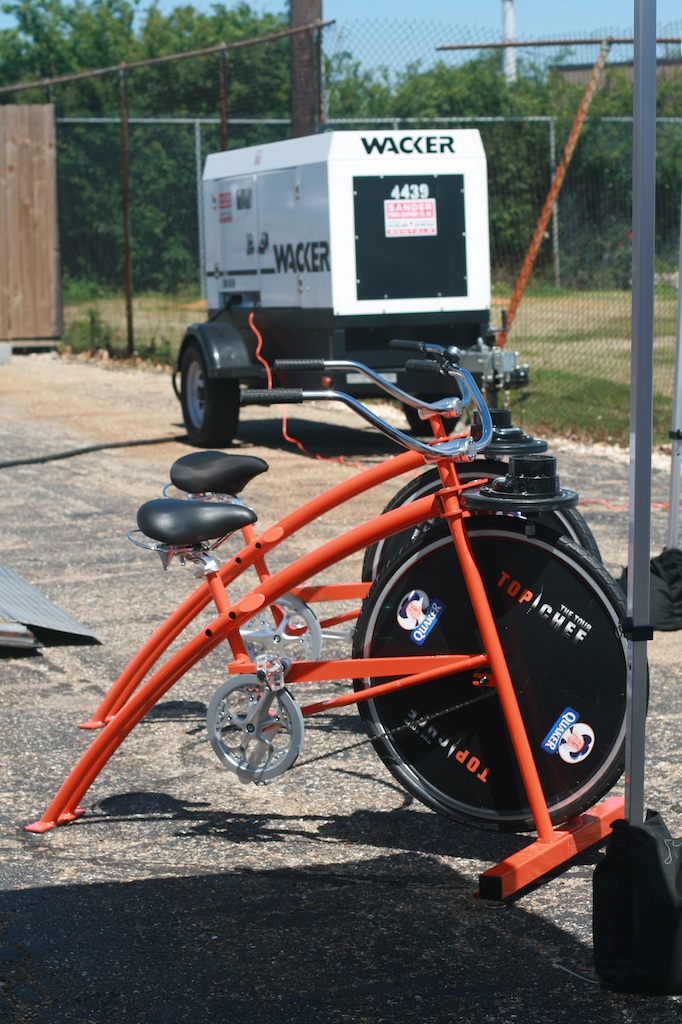
We brought home broccoli…

Carrots… (notice his face? I couldn’t get him to smile, until I asked him to talk about toilets…)

…and now he’s smiling.

And Cauliflower.

Here’s the question: what would you make?? All veggies together? Roasted Cauliflower? Broccoli cheese soup? A casserole?
Ideas and suggestions welcome!!
Monday Night: Impromptu Mama Night!
We were in the neighborhood, so we stopped by Emmy’s yesterday afternoon. Emmy was exhausted, as was I, but we both seemed a little recovered by company and the sight of each other’s kids. We scheduled for an late afternoon rendezvous back at her place.
Joined by friend Georgia and three large frozen adult beverages, we took over their neighborhood. Six kids (Emmy’s three, my two and Georgia’s one) to three Mamas, supported by slow-sips and conversation. They picked kumquats (my kids thought they were funny-tasting tomatoes, aye), swung on tree swings, and played in wooden forts. No one was stung by a caterpillar or eaten by red ants.
By the time we came up for air, it was 6:30. Monday is movie night, right?
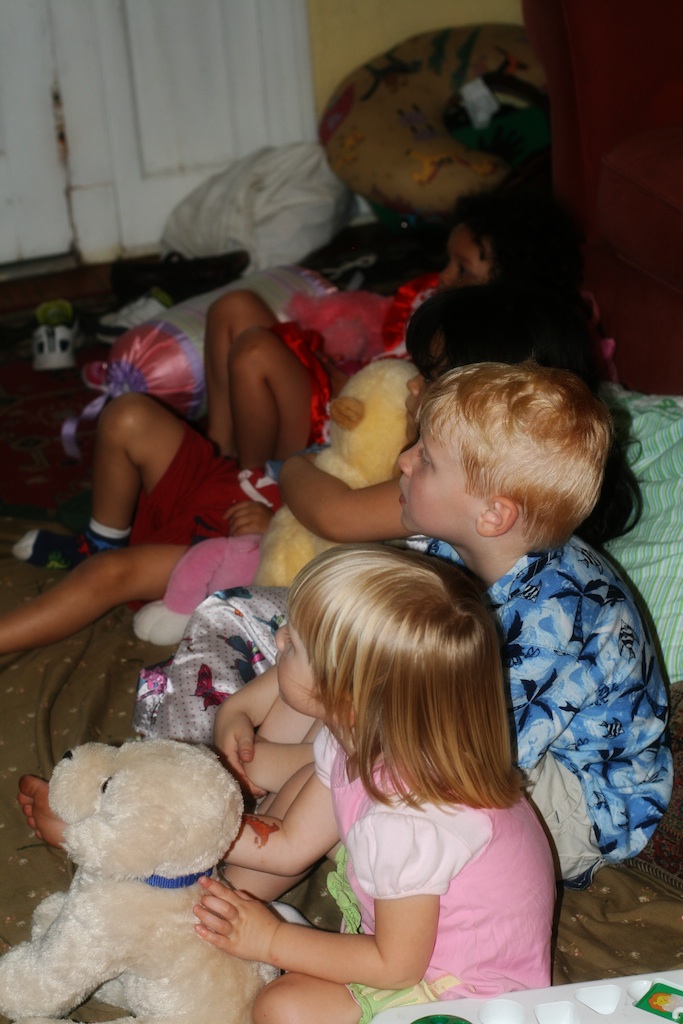
Monday Movie was Madagascar.
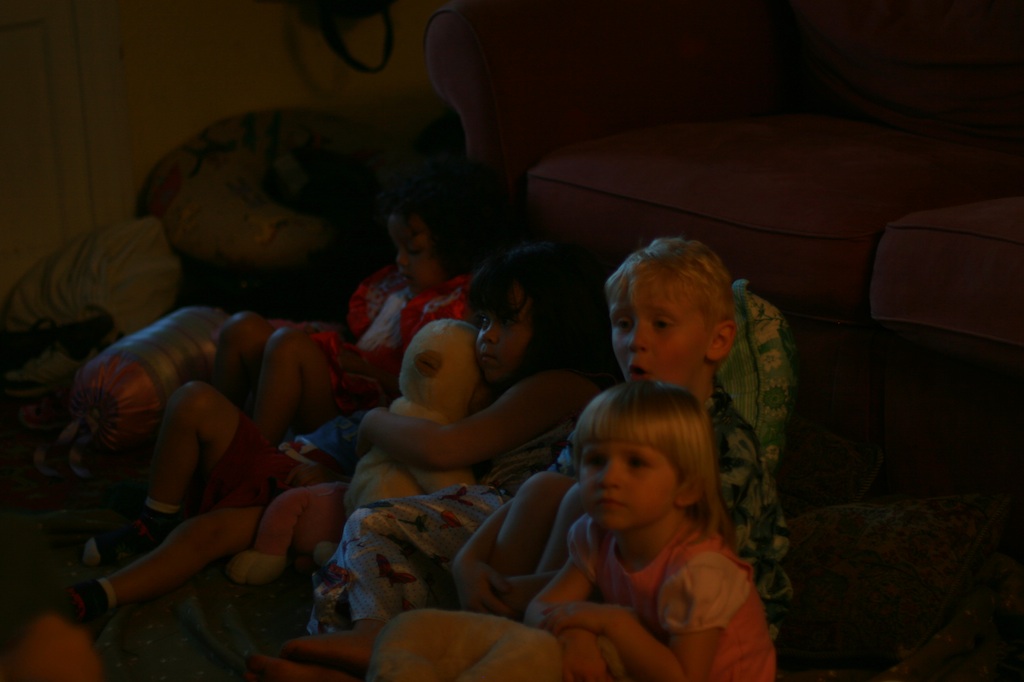
It came with pizza.
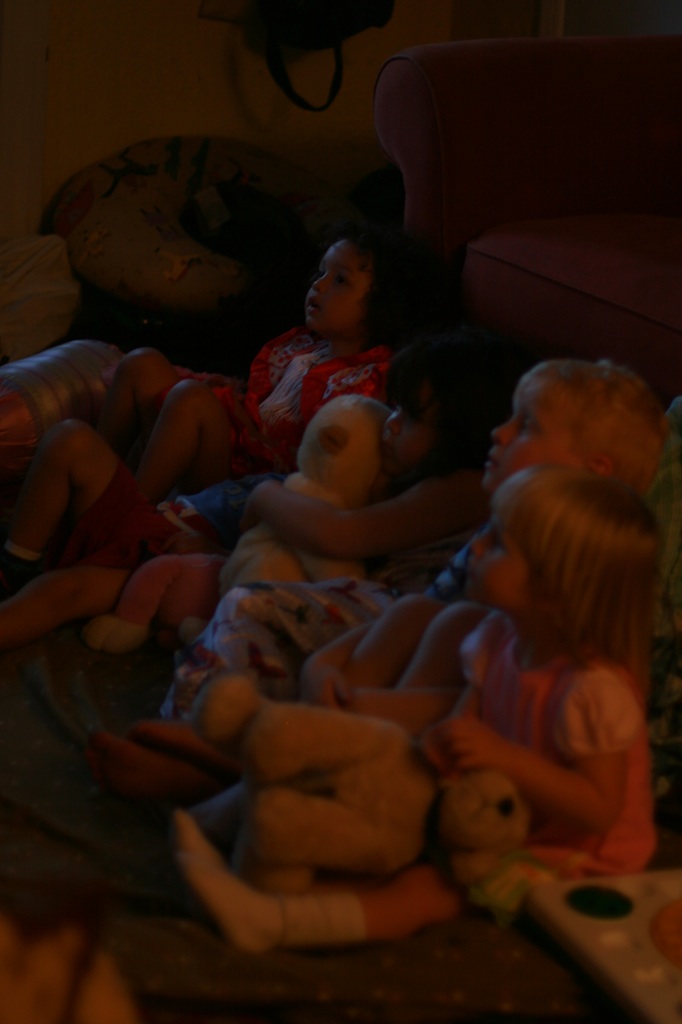
It also comes with plenty of MOVE IT MOVE IT.
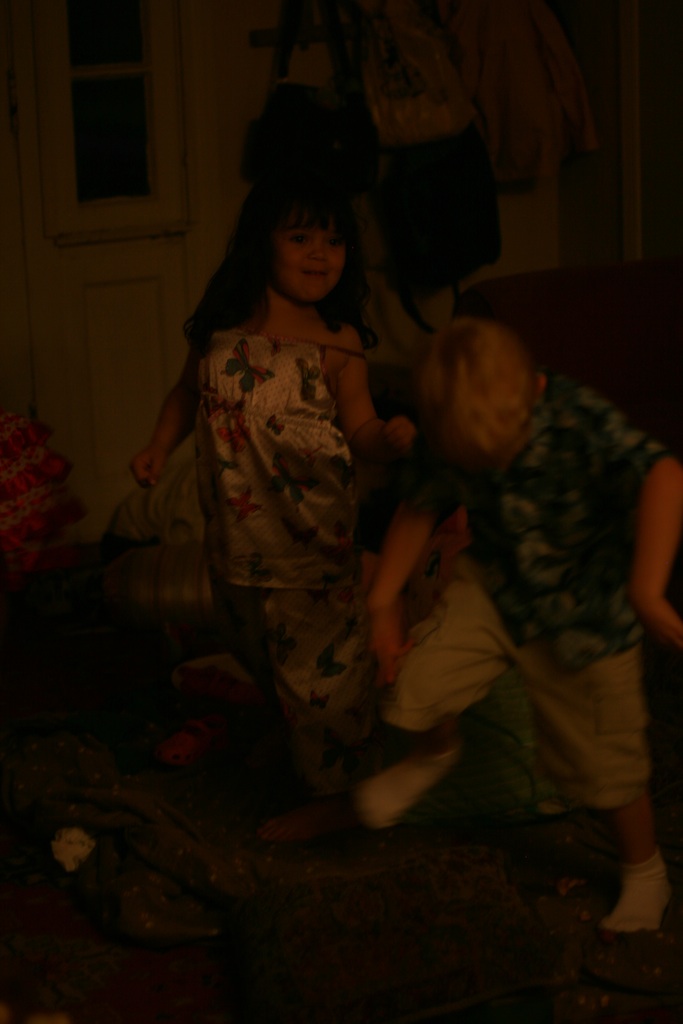
Which meant that Will could put his moves to use.
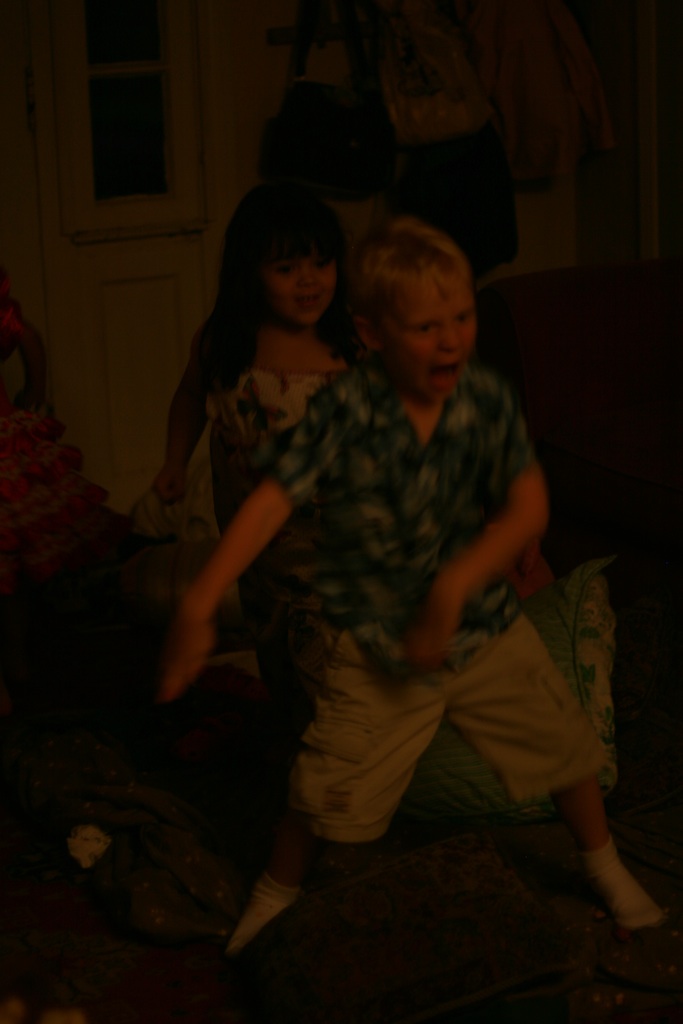
It was exactly what I needed — maybe what we all needed? Good friends, cold drinks, quality conversation, fun time with the kids, and mostly… a reminder to chill.
Somehow, it doesn’t seem like enough, but THANK YOU. THANK YOU THANK YOU THANK YOU.
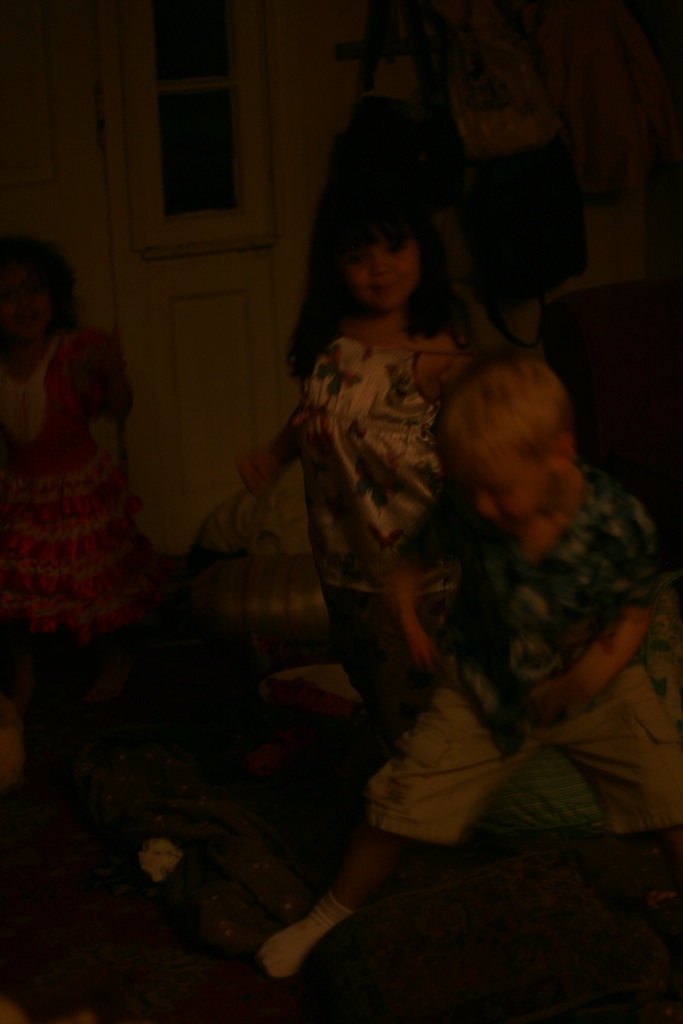
March Just Posts
A good friend of ours is a Peace Corps volunteer in South Africa. She doesn’t have a blog (despite my ardent encouragement and hopes of it, the remoteness of her assignment make it easier to simply send an email when possible) but when she writes, she does so with beauty and thoughtfulness and reflection.
Which is why I am posting a passage in one of her last email’s here.
I know that the tone of my letters and email about my time in South
Africa have been mostly up-beat and generally full of the anecdotes
and general hilarity that come with learning and blending with a new
culture as well as my usual crazy adventures. Â All of these are very
accurate and quite true, but I think it is important for me to convey
that this is also only half the story. Â The cultures of South Africa
tend to downplay things undesirable or possibly unbecoming, and there
is a very vibrant tradition of singing-through-the-tears. Â It is easy
therefore, coupled with my personal mental default-setting being humor
rather then melancholy, to simply write my letters to those far away
about the superficial ups and downs of daily life without delving into
the harder daily experiences which are a communal understanding yet an
elephant-in-the-corner with my fellow PCVs and community members.Therefore, in an effort to share some of the other realities of life
in South Africa, this is a little more about the situation and
community of which I am now a part.I live in a village without a clinic. Â It has one tar road, one shop
to get bread and a few other sundries, one ‘bottle shop’ for the
procurement of alcohol, and one primary school. Â It has three
burial-grounds. Â In a country where one in five people are
HIV-positive and upward of 95% have latent tuberculosis, this ratio of
cemeteries to services is far from uncommon. Â About half of the
patients at my organization are wheelchair bound, yet we are located
off of a dirt road on uneven and rocky terrain – just like their
houses (if they one of the fortunate amongst our clients and have a
house). Â My community members have lived their whole lives in full
visibility of the platinum mines and limestone quarries which produce
a sizable wealth for the upper-echelons of the country, but they will
never see even enough of that money to pay a visit to the private
hospital in Rustenburg (35 km away) to get the medications they need
when they are sick. Â My host brother came home mad as hell on Friday
night – Good Friday – after witnessing a car accident in which six
people were injured because someone in a sports car going to the
largest casino on the continent (20 km away) wasn’t paying attention
when making a turn. Â Two of those people will get the care they need,
and afterward make it to the near-by resort, the place where, if they
were lucky (not to mention survive the accident), the other four could
potentially get a job, but never afford to visit. Â South Africa is a
place where the “first-world†and “third-world†sit in uneasy
juxtaposition. Â Unlike where infrastructures are non-existent or there
is more homogeneity in the human condition, poor South Africans see
every day the things they will never have (there is no judgment in
that statement of who is worse off, it is just a thought on the range
of hardships being undertaken by different populations).If you have read this far, thank you for humoring me. Â Again, I am
always more then happy to talk more deeply about any of these subjects
or to entertain questions. Â I also hope that it is understood that
these truths aren’t the only side of the story, either.  I am always
and continually amazed at the resilience people have to all that is
thrown at them. Â South Africans sing, they sing a lot, but there are
also many tears.
I love the contrasts within her discussion and how they serve as a way to understand the human condition within — one school to three graveyards, affluence to poverty, accident to luck. Reasons why, she argues, for there to be many tears — but also (and this is where I start to pull her words a little further) reasons why unrest, uprising, and violence may be not only common but justified in this type of environment.
One of my passions in public health is ecological research — or, literally, studies that look to how a total environment (particularly social environment) impacts health. This mode of research is still quite new, but exploratory studies suggest that when great divisions in wealth and poverty exist within a community, everyone within it experiences less optimal health. In short, what we are starting to understand (at least, scientifically) is that common good benefits everyone. It doesn’t take a lot of thought, then, to see why staying in Louisiana is important to me, at least, as a scientist.
This month’s Just Posts give fuel to the common good fire — and, as always, do so in varied and inspirational ways. Giving props to corporations moving to fair trade products, discussing the importance of math and realities of education in poor regions of the world, illustrating the connection between cheap and available produce to labor exploitation, celebrating notable “Days” in March with personal stories and insight.
Thank you, readers and writers! And please please — if you read something this month that inspires and informs and would be perfect for the next roundtable, send it on!
The March Just Posts
- Thailand Chani of Finding My Way Home with Would you like to be a hero?
- TeacherC at An (aspiring) Educator’s Blog with Investigating Social Inequity in the Mathematics Classroom
- Tash at Awful but Functioning with Whadaya Know Georgia.
- Rebecca at Flying Tomato Farms with The cost of a winter tomato
- prof susurro at like a whisper with Today is World Water Day and Women Aviators Make Herstory
- Paul Newnham of Give a damn about poverty? with Congrats Cadbury and Fairtrade this Easter
- Painted Maypole of Painted Maypole with An education in the jungle
- Mary at Them’s My Sentiments with A House Made of Asbestos
- Mad at Under the Mad Hat with More posts about buildings and food
- Kyla at The Journey with The Speech
- jen at One Plus Two with day 37: getting real
- girlgriot at If you want kin you must plant kin with Preach Responsibly and Missing the Point
- Erika of Be gay about it. with And so we wait.
- Em at Social Justice Soapbox with some random thoughts on giving
- Curtis at can’t see the forest with Beautiful Horizon, where hunger is on its way out
- Christopher at One Dollar Diet Project with (f)armed conflicts
- bon at cribchronicles with stuck in the freudian anal phase
- Ann Douglas at ParentCentral.ca with The Other Mothers
- almost idealist at One Year to Change the World with Equality for women: 2009 and we’re still not there and Time for a change
- alejna of collecting tokens with finding a way to volunteer with my hands full
This month’s readers:
Alejna, my JP accomplice, has words of wisdom with the list, as well as lyrics and performance of the very song whose lyrics graced the wall above my desk through college and at least three jobs (as if I needed more evidence of how much she rocks?!) — please stop over and say hello!
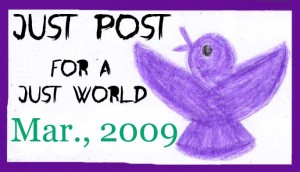
Red Ants Marching
They wait between the bridge and the bird island, very close to mediation walk. Not the only red ant mound in Audubon Park, but certainly one of the largest. So large that toddlers may find the urge to climb it.

She did it on Sunday, a week ago. Falling into the pile meant that her hands and knees took the most punishment. Little puss-filled bites are on her fingers on palms. A few trail down her legs. Paul was there in a second — we saw it happen before it actually happened — to beat the ants off of her, taking a few bites of his own. It was traumatic for all of us.

The sight of any bug, especially an ant, has become a terror for her — something her brother has started to exploit. (“Look, Kate, there’s an ant on my truck!” — “Oh no!” says Kate, promptly dropping truck.) Who knew Kate could develop a phobia?

We’ll see how long it lasts — and how long these take to heal. As for the ants, I’ve written the Audubon Park people… and I hope they blast those varmints to smithereens.

Tough Times.
We don’t want to leave New Orleans.
But we’re preparing to do so.
It’s been several stressful months here after Paul’s contract evaporated a few months earlier than expected. He’s got a wonderful start-up in the works, but it’s a start-up… it’s not a job. And it’s not close to being finished. Our expenses, which are almost completely made up of three things (house, kids’ school, health insurance), have eaten through our savings… again. This has happened to us before. Job lay-offs have put us within 2-3 months of losing it all at least twice since getting married. But we have always managed to work it out.
And we’re trying to work it out. We should be able to work it out.
But here’s the rub: while it’s hopeful that Paul will have 8 more weeks of billable work coming soon, after that…? After that, the options are very limited. There is no high tech in New Orleans. My assorted jobs will not carry us — living in a high-expense city means that Paul must work. What if there is nothing after this 8 weeks? Then what? The stress of that question alone is a pretty tremendous weight.
We know we have to start preparing, just in case. Which means we’re looking around thinking about what we have to do to get the house ready for sale, or possibly (hopefully?) lease. We’ve canceled the extras. We’re selling things (anyone want Impacto Zero? Or a double stroller? For that matter, email me if you want our house!) We’re trying to see if Will can attend First Grade at an Immersion Charter School (since he’s 62nd on the wait list for Kindergarten), in the event we can work it out to be here in the fall. Maybe I can try to beg Kate into the one that takes 3 year olds?
We’re debating.
Overseas….? Well, I’d need to find work. It would be cheaper to live. The kids would still have immersion in a second language. Paul could work on the start-up full-time and we’d live off my salary. I could only do it for a year or so because then I’d have to get back to finishing my dissertation, which I would not be able to do while holding a full-time job.
Move to the NOLA suburbs…?  We’d be staying in the States and could keep the kids in an Immersion school. Paul would still have to work somewhere, and we wouldn’t need as big of a salary… but he wouldn’t be challenged. We’re not really suburb people, but it wouldn’t be as bad here as other places.
Move somewhere for a job for Paul…? This one scares us the most. He could easily get a job in the DC area, but the thought of us moving up there hits like a death sentence.
Move somewhere else for a job for either of us…? The irony is that Louisiana is the best place for me — it’s the least healthy place in the United States and ground zero for all my skills and interests. But there is no work here (part of the reason our health outcomes are 50/50 across the board.) Where else could we go?
It feels so odd for both of us to have so much promise, talent, and skill… and to have to struggle to put it in the place we want most to give it.
The bottom line is that like so many others we are filled with uncertainty. I force myself to ignore it, we’ve done it before and I can’t destroy myself dwelling on one more thing. (I spend enough time worrying about house fires and driving into a lake.) The high cost of living here? It’s wearing us down, frankly. Paul’s digestive system sounds like an espresso machine and my eyes look like I’ve been boxing without a mask. How long until we break? Do we keep trying to work it out, or do we bail? And if we bail, we run out of here and to….?
We just don’t know.
Bunny Salad
Too much candy on Easter? Try the BUNNY SALAD…
Step 1: Assemble ingredients. Pears, lettuce/spinach leaves, carrots, strawberries, cottage cheese, peppercorns. A plate for your garden, peeling tool, and cutting board are also useful. Note that the actual recipe calls for fully-sized carrots and cloves, which will screw you up later, so be prepared to roll with it.
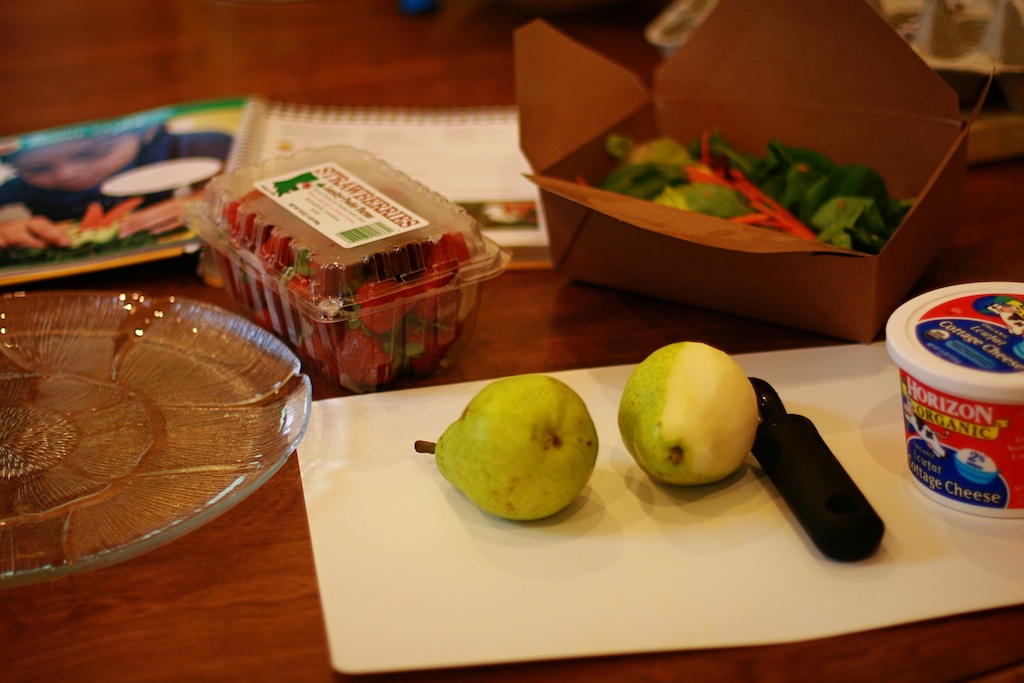
Household bunnies are optional. Note that if you take one to the store, there will be a lot of pointing and giggling.

Step 2: Contemplate safety of child’s fingers, then say, “F* it” (to yourself, please) and let them go to town with the peeler. Consider counting fingers before he starts, just in case.
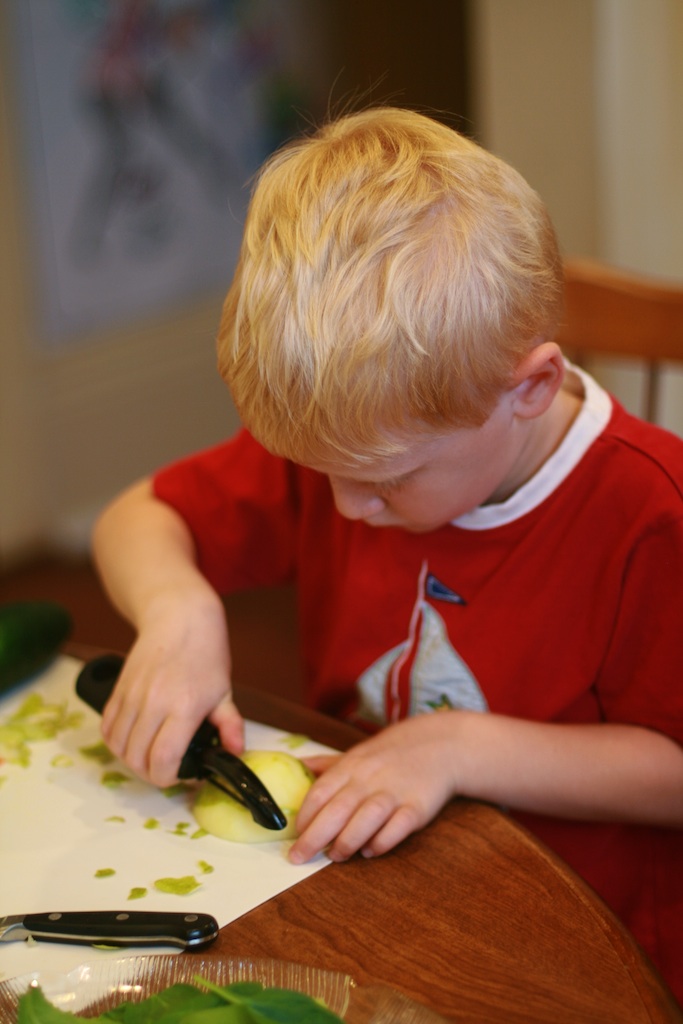
Step 3: Use a knife to cut peeled pear in half. Keep the stem on the end for a nose, if you like. Use the peppercorns and carrots as eyes and ears.
Damn. The string carrots won’t work. Substitute pear peel.
Damn. Pear peel won’t stick. Neither will peppercorns. Realize you screwed up.
Get creative. Dig some holes for the eyes. And ears.

Step 4: Get smart. Use toothpicks. Let the kid cut the toothpicks before insertion, he’ll love it.
Pat yourself on the back for being such a Super Mom.

Step 5: Notch that Super Mom status up a few bars by letting the 5 year old use the KNIFE. The emergency room won’t judge you, you creative Mom, you!

Step 6: Add strawberries and carrots to the lettuce patch. You’ve got bunnies in the garden!
(Note: if you haven’t already realized that you need two bunnies for your two children, hurry and make a second. Substitute whatever necessary to make it work.)
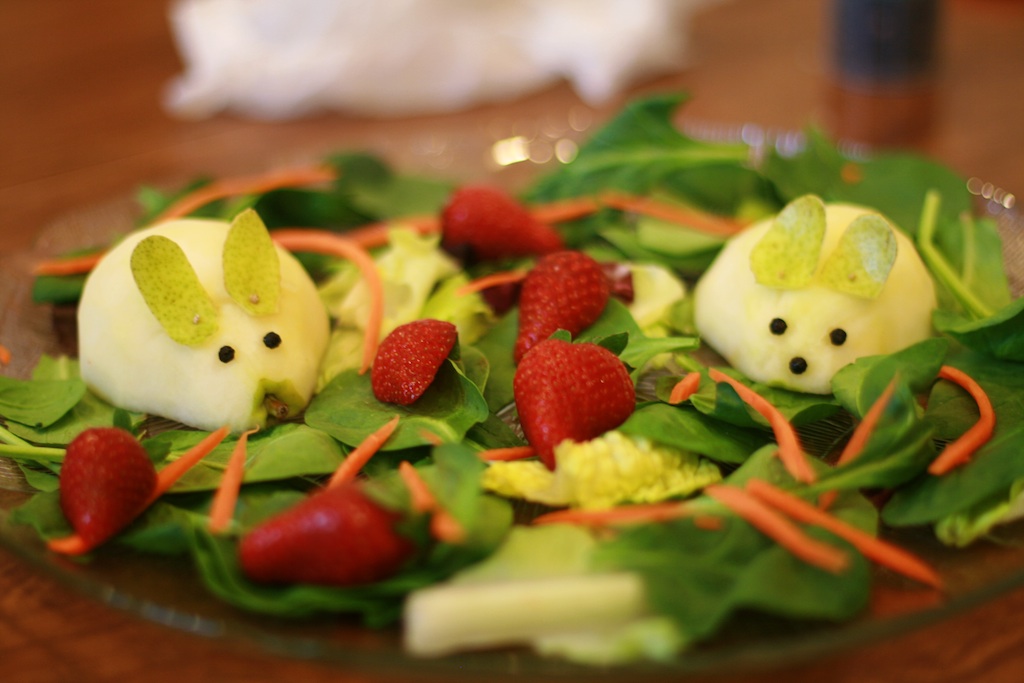
Step 7: Don’t forget to use the cottage cheese to make fluffy bunny tails!

Step 8: Have your kids pose with their salads so you can send them to Mothering and Parenting websites and magazines. You need to document your awesomeness.

Step 9: Realize that your kids may begin to get that the salad is a ploy to distract from eating Easter candy. Be prepared to talk up the awesomeness of the salad!
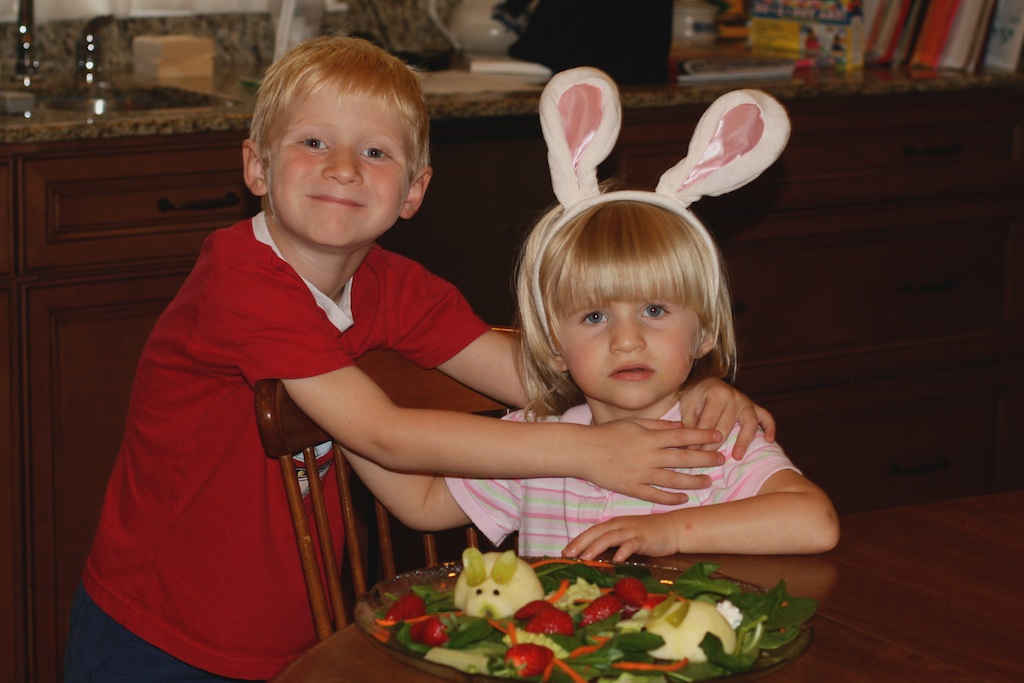
Step 10: Reward children who eat bunny salad with Easter candy. As if it would end any other way.
